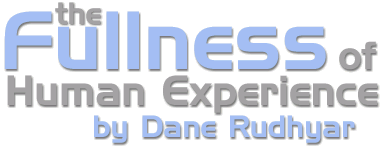 |
| Home | Bio | Art | Music | Literature | Civilization & Culture | Philosophy of Wholeness | Theosophy & Spirituality | Astrology |

CHAPTER TWO
Wholeness and the Experience of Periodic Change - 1 The dynamism of Wholeness When a definable or identifiable boundary can be given to an energy field in which the activities of a number of elements are functionally interrelated, this field constitutes a "whole." The wholeness of this whole results from the coexistence of a state of multiplicity (the many elements the field encompasses) and a state of unity (the fact that these elements are circumscribed by boundaries). Any boundary-defined field of interrelated activities is thus a particular manifestation of wholeness, regardless of how few or many the number of its constituent elements and how limited or extensive its defining boundaries. Boundaries separate a whole from other wholes, yet all these wholes may in turn be seen as parts of a greater whole containing them all as components. At the metaphysical level of universally applicable and therefore inevitably abstract concepts. Wholeness may be understood as the interrelatedness of two fundamental principles. Unity and Multiplicity. Moreover, the most common and primordial experience of human beings is that of continual change — a change which may alter to some extent the boundaries of any whole and the nature of the forces active within them which affect other organisms. Therefore, one is led to assume that the relationship between these two principles. Unity and Multiplicity, is also constantly changing, change implies motion, whether it be the motion of material particles or the development of intellectual concepts. Motion can be observed everywhere and at all times. As Heraclitus stated twenty-five centuries ago, the only thing that does not change is change. Motion and change may not be at first or superficially perceptible, but the more developed the sensitivity of the senses and the capacity for subtle feeling-reactions and intellectual analysis, the more evident the universality of change. What may at first appear to be a permanent, unchanging entity (or a situation involving several entities) sooner or later is understood as a relatively stable interplay of moving factors and patterns of relationship, which often undergo a rapid or slow series of transformations. Wholeness can only be given the character of a static reality when the primary and incontrovertible human experience of change is dismissed as illusory. But to do so reveals a very basic sense of inner insecurity which the religious or metaphysical mind tries in vain to hide by postulating a changeless Supreme Being who must be transcendent and therefore external to and separate from the world of change which It has created for a purpose no human mind can fathom. Wholeness is dynamic because it implies motion. Moreover it seems justifiable to give a rhythmic, thus cyclic and repetitive character to this motion. It is an ordered kind of motion. It has a structure — using the word, structure, in its most abstract sense. The feeling-realization of structure emerges from a basic fact of human experience, to which philosophers usually have not given enough attention: the fact that some changes are experienced by a newborn human as having already been experienced. This phenomenon of recurrence radically modifies the experience of change. Particularly strong experiences of pleasure or pain, which had focused the attention of the child's organism, are remembered. Some definable change made them happen. In order to understand what the change was related to, and thus perhaps how it could be made to happen again (or be avoided if it was painful), a new faculty begins to develop in the child's organism: mind. And mind, as we shall soon see in greater detail, is the ability of an organized whole to discover, invent, and develop a mode of operation — a procedure, strategy, or device — which makes possible the repetition of pleasurable (and in general "desirable") experiences, and the avoidance of painful ones. Another realization soon follows, which at a later stage of human development becomes crucially important — the realization that the recurrence of a desirable experience can be accelerated if the child makes use of the strategy suggested by his or her mind; for instance, by crying in a certain way, or (later on) by imitating parental behavior and doing what they apparently expect. In other words, the primary experience of a human being is not only that of unceasing changes; it is qualified or modified by two other basically important realizations: the expectable recurrence of certain changes remembered for what they had produced in the experiencing organism, and the realization that what is remembered can be made to occur again, if specific procedures (movements of parts of the body) are followed. Thus there is unceasing change; change is at least to some extent repetitive; and the recurrence can be accelerated or delayed. Because this feeling of acceleration or delay in the satisfaction of vital needs (and later on, ego-desires) becomes an integral part of the child's consciousness as it reacts to everyday experiences, what may be called the sense of time develops. It takes specific forms according to the conditions of existence and the needs and wants of the growing child; but it is also basically affected by the attitudes displayed by the family, school, social class, and by the culture having molded their collective responses. By permission of Leyla Rudhyar Hill Copyright © 1986 by Leyla Rudhyar Hill All Rights Reserved.  Web design and all data, text and graphics appearing on this site are protected by US and International Copyright and are not to be reproduced, distributed, circulated, offered for sale, or given away, in any form, by any means, electronic or conventional. See Notices for full copyright statement and conditions of use. Web design copyright © 2000-2004 by Michael R. Meyer. All Rights Reserved. |
 |
